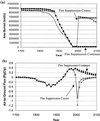Projecting the future of the U.S. carbon sink
- PMID: 11830663
- PMCID: PMC122200
- DOI: 10.1073/pnas.012249999
Projecting the future of the U.S. carbon sink
Abstract
Atmospheric and ground-based methods agree on the presence of a carbon sink in the coterminous United States (the United States minus Alaska and Hawaii), and the primary causes for the sink recently have been identified. Projecting the future behavior of the sink is necessary for projecting future net emissions. Here we use two models, the Ecosystem Demography model and a second simpler empirically based model (Miami Land Use History), to estimate the spatio-temporal patterns of ecosystem carbon stocks and fluxes resulting from land-use changes and fire suppression from 1700 to 2100. Our results are compared with other historical reconstructions of ecosystem carbon fluxes and to a detailed carbon budget for the 1980s. Our projections indicate that the ecosystem recovery processes that are primarily responsible for the contemporary U.S. carbon sink will slow over the next century, resulting in a significant reduction of the sink. The projected rate of decrease depends strongly on scenarios of future land use and the long-term effectiveness of fire suppression.
Figures



References
-
- Pacala S W, Hurtt G C, Baker D, Peylin P, Houghton R A, Birdsey R A, Heath L, Sundquist E T, Stallard R F, Ciais P, et al. Science. 2001;292:2316–2320. - PubMed
-
- Caspersen J P, Pacala S W, Jenkins J C, Hurtt G C, Moorcroft P R, Birdsey R A. Science. 2000;290:1148–1151. - PubMed
-
- Hurtt G C, Moorcroft P R, Pacala S W, Levin S A. Global Change Biol. 1998;4:581–590.
-
- Moorcroft P R, Hurtt G C, Pacala S W. Ecol Monogr. 2001;71:557–586.
-
- Ramankutty N, Foley J A. Global Biogeochem Cycles. 1999;13:997–1027.
Publication types
MeSH terms
Substances
LinkOut - more resources
Full Text Sources

